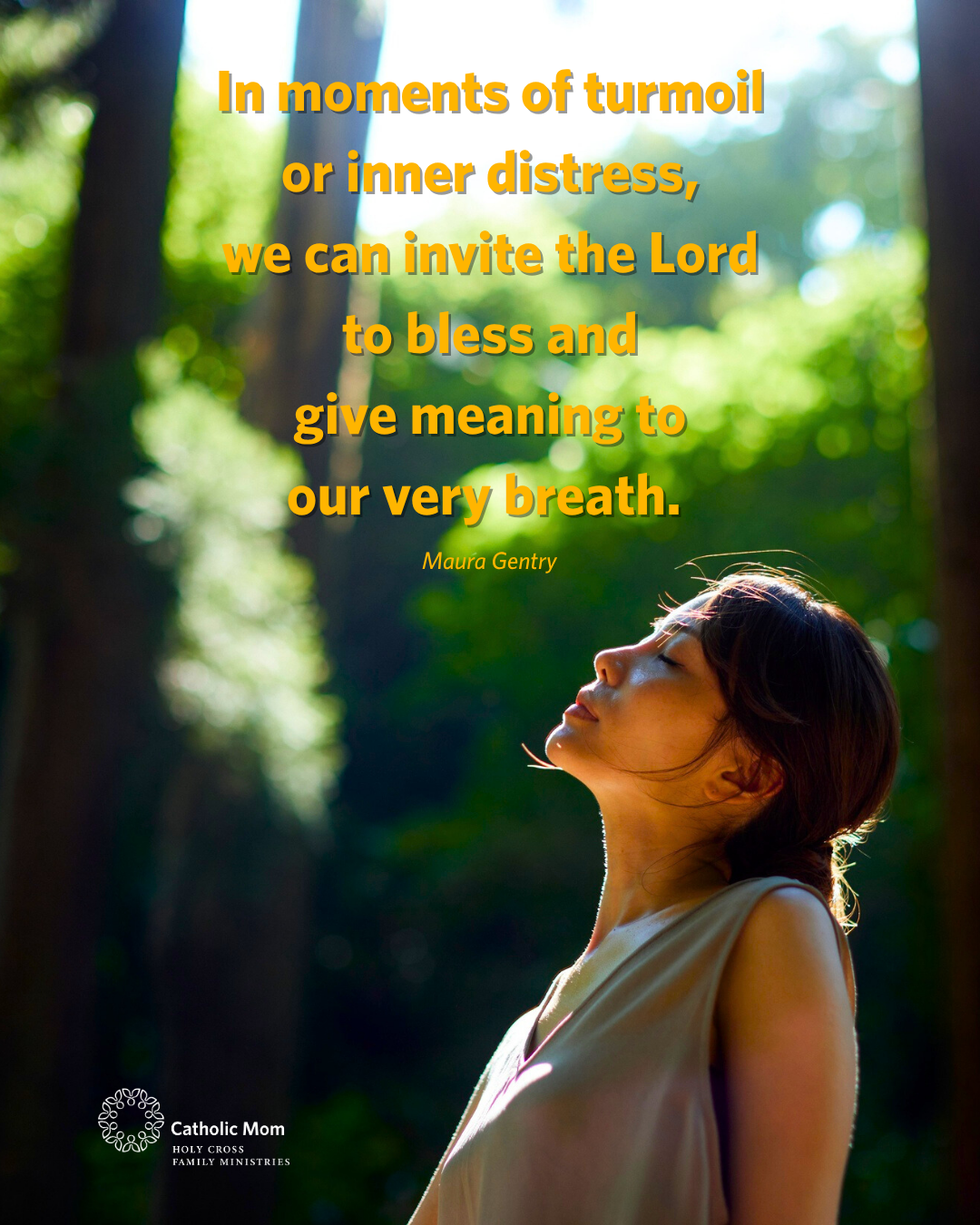
Maura Gentry explains how a common breathing technique can be adapted for use as meditative prayer.
“Take a deep breath,” I instruct my son, who at a year and a half is better at taking deep breaths to calm down than I am. I hear him audibly breathe in the back seat, and though it doesn’t solve his frustration, it does calm him a bit.
I don’t remember at what point we started teaching him to take deep breaths, but it’s one of the best parenting tools we’ve got. I credit my husband with using this tactic; in fact, he is the one who has been most successful at helping me breathe through my anxiety. After dealing with severe panic attacks in high school, I find that breath regulation can still be a challenge when I’m anxious or upset.

Breathing Together
The greatest thing about teaching our son to take deep breaths is that it encourages us to breathe together. There’s a synchronization that happens in our minds and hearts as well as our bodies when we pause and focus together on this universal action.
Someday, I’ll teach him a method that I learned in therapy known as four-square breathing or box breathing.
Many studies have been performed on the efficacy of box breathing, a simple relaxation technique that can help you focus, calm yourself, or even can be used in the practice of meditation.
To practice box breathing, there are four steps with a duration of four seconds each.
- Breathe in
- Hold the breath
- Breathe out
- Hold the breath
I once read about a way of setting this practice to prayer. For me, it has turned a somewhat banal and occasionally difficult practice into something much more meaningful.
Breath as Prayer
Turning this practice into prayer involves meditating on three postures of the Blessed Virgin Mary’s heart: ecce, fiat, and magnificat. Ecce means “behold.” Most often we will hear it in the context of the Mass when the priest elevates the host for the second time: “Ecce Agnus Dei: Behold the Lamb of God.” Mary’s first response to the Angel Gabriel was to say, “Behold, I am the handmaid of the Lord” (Luke 1:38).
Just as Mary presented herself before the Lord as she was, so should we, without pretense or masks. Ecce is the posture to emulate for steps two and four of the box breath exercise. As we find ourselves fully at rest, we can invite the Lord in to love us as He made us: no more, no less.
Fiat means “let it be done unto me,” or “yes.” Mary gave her fiat to the Archangel Gabriel when she said, “May it be done unto me according to your word” (Luke 1:38) With this one word, Mary cooperated with the Lord’s will to change the course of human history. As we breathe in the first breath of the exercise, we invite the Lord into our hearts and minds. May we adopt the posture of Mary in her fiat, allowing the Lord to work in our lives the way He wishes, rather than the way we think He “should.”
Finally, magnificat refers to Mary’s prayer of praise after accepting the Lord’s will in her life through the message of the Archangel Gabriel. She begins with “My soul proclaims the greatness of the Lord; my spirit rejoices in God my Savior” (Luke 1:46). This is the phrase we meditate on when breathing out, step three of the box breath. May our first words always be praise for the Lord, before anything else.

In this way we can turn a useful, meditative breath into a much deeper reflection on the life of the Virgin Mary and on the effect of God’s grace in our own lives. In moments of turmoil or inner distress, we can invite the Lord to bless and give meaning to our very breath. Breathing in, we say yes to God’s plan for our lives, allowing Him to enter our hearts and minds. As we hold our breath, we ask Him for the grace to allow Him to love us as we are in that moment. With our exhale, we give Him praise; and, again, we give Him room to see and love us completely as we are.
Though my son is too young to practice this now, I look forward to the day when I can teach him about our Blessed Mother and the Lord’s love for him in this way. One of the best things about this practice of prayer — and breathing — is that it can be so easily adapted to fit the needs of different age groups and family settings.
Let everything that has breath give praise to the Lord! (Psalm 150:6)
Share your thoughts with the Catholic Mom community! You'll find the comment box below the author's bio and list of recommended articles.
Copyright 2025 Maura Gentry
Images: Canva
About the Author

Maura Gentry
Maura Gentry is a librarian by trade and a writer by necessity. A wife and mom, she writes during nap time, in-between meal planning, and late at night when the house is (blessedly) quiet. She enjoys reading the classics, crochet, and singing. Living a literary life is one of her passions, and you can find her writing about it over at The Catholic Librarian.


.png?width=1806&height=731&name=CatholicMom_hcfm_logo1_pos_871c_2728c%20(002).png)
Comments